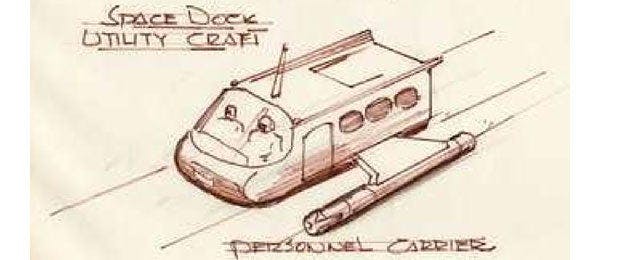
Today, in our guest blog, Star Trek enthusiast Steve Thomas chronicles the real-life travails of Star Trek's iconic shuttlecraft, the Galileo 1701/7. This is part one of an extensive two-part feature that includes photographs and video.
September 8, 1966…or “Stardate: 6609.8,” if you will. It’s a date that marks the television premiere of what would become an American icon in science fiction: Star Trek. So much of what came from that show is a part of our society and of our planet that it’s hard to imagine what things would be like if Star Trek had never been.
The starship USS Enterprise was the ship that took our imaginations on a great ride. And aboard each version of the Enterprise there have been shuttlecrafts, including the equally iconic Galileo NCC-1701/7.
HER REALIZATION
In episode #13, “The Conscience of the King”, Kirk takes Lenore Karidian to the observation corridor that overlooks the hangar deck and refers to the shuttles there. (SEE IMAGE 1)
Though mentioned, the production couldn’t afford to build a shuttlecraft, which is why the transporter was so prominent. Transporter effects were inexpensive versus shuttle effects. In “The Enemy Within” (#5), Sulu and his landing party could’ve been easily saved by shuttle when the transporter (and apparently all transporters) was damaged.
Episode #14, “The Galileo Seven,” finally revealed this previously unseen aspect of the Enterprise. Production designer Walter “Matt” Jefferies, who designed the Enterprise, was asked to design a shuttlecraft. What he came up with was a craft that was sleek, smooth and curved. (SEE IMAGE 2)
Its curvilinear lines were evocative of her mother ship, but such lines also made it too costly to construct. Jefferies also sketched ideas for other vehicles like a “Space Dock Utility Craft” (look familiar?) (SEE IMAGES 3 & 4)
WHO DESIGNED HER?
Gene Winfield (SEE IMAGE 5)
At this point, things get interesting. The model company “AMT” offered to build the full-scale mock-up of the shuttle in trade for the model kit rights (AMT had the license for the Enterprise and Klingon ship models). They turned to custom car designer Gene Winfield, who was head of their “Speed & Custom Shop”.
“We built the [Star Trek] shuttlecraft, full-size shuttlecraft that was two separate units,” Winfield said. “One would be a complete exterior, full size. Then we built the complete interior. This interior had what we called ‘wild’ walls. What you do is you make the walls in four-foot sections on wheels so you can put up one wall and they could film the actors sitting on the seats and whatnot.”
Matt Jeffries
Note that he says “built” the shuttle, not “designed” and built. There apparently was some connection with AMT and/or Gene Winfield with industrial designer Thomas Kellogg. He is known for designing the Studebaker “Avanti” – its front end styling is similar to the Galileo’s front end). (SEE IMAGES 6 & 7))
It should be noted that in an interview, Matt Jefferies (SEE IMAGE 8) says that Winfield designed the shuttle, but Thomas Kellogg’s obituary also states that he designed the shuttle. I believe it was a collaborative effort, with Jefferies’ “utility vehicle” selected as a base design by Kellogg, who was working under Winfield; and Jefferies putting the finishing touches on that design. Winfield’s department constructed the finished design. (SEE IMAGE 9)
Were Jefferies original design built, the Galileo would’ve looked mostly like this 3-D model by Vance Bergstrom. (SEE IMAGE 10)
HER CONSTRUCTION
AMT’s offer to build the shuttle allowed the production to go ahead with “The Galileo Seven” episode. Here are pics of the Galileo under construction at AMT Phoenix. (SEE IMAGES 11-14)
Visit StarTrek.com again tomorrow to read the second half of Steve Thomas' blog about the mysterious fate of the Galileo 1701/7.
-----------------------------------------------------
Steve Thomas is a longtime Star Trek fan and runs the Starfleet 1701st costuming group, which focuses on Starfleet costumes from all the Star Trek television shows and movies. He's been passionate about finding the Galileo for several years now.

